Pat Mora's Blog, page 74
November 14, 2011
Creativity Interview: Monica Brown
I'll begin by saying: I've had the pleasure of occasionally spending time with warm, energetic and talented Monica Brown. Congratulations on your eleven wonderful children's books, Monica! Welcome to Bookjoy Creativity Salon!
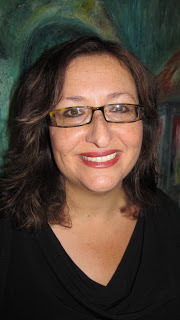 1. You are an author, presenter, professor, friend and inspiration to many, and a family member. Wow! Do you enjoy your academic life?
1. You are an author, presenter, professor, friend and inspiration to many, and a family member. Wow! Do you enjoy your academic life?
MB: I do enjoy being a professor—for the decade before I started writing children's books I had the pleasure of teaching and writing about the most amazing Latino/a literary works and introducing college students to new worlds of literature. I think the best preparation for writing is reading, so I had the best training of all. First, teaching, researching, and talking about Latino/a literature and then I began creating Latino/a literature for children, inspired by the birth of my two daughters, Isabella and Juliana. I wanted them to know who Gabriela Mistral was, who Celia Cruz was.
2. Is there a connection between that life and your work as an author for children? Has being a writer changed your teaching?
MB: The two are intimately connected, in mostly positive ways. For example, when I was researching my book on Gabriel Garcia Marquez, I decided to develop a new class—a comparative literature of the Americas. I taught a senior seminar that compared magical realist texts by U.S. Latino/a authors such as Luis Urrea's The Hummingbird's Daughter, Ana Castillo's So Far from God, and Marie Arana's Cellophane to South American novels such as Isabel Allende's House of Spirits and Gabriel Garcia Marquez's seminal One Hundred Years of Solitude, a book that changed the direction of my life. I first read One Hundred Years of Solitude when I was a senior in high school and it captured me as no other, perhaps before or since. This teaching and writing led me to the publication of my very own magic realist text for children, Chavela and the Magic Bubble .
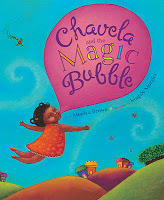
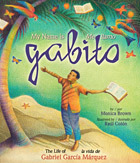 3. Tell us briefly about your publishing journey and your newest books
.MB: My publishing journey is long in that it started, I think, long before I published my first children's book, and even before I published my first scholarly book. My mind, even as a child, was never quiet, for better or for worse. In some ways I had a fairy tale journey into children's books because the first manuscript I ever wrote, on Gabriela Mistral, secured a publisher and the first book I ever published,
My Name is Celia: The Life of Celia Cruz/Me Llamo Celia: La Vida de Celia Cruz
(and the second I wrote), was honored with awards. But I like to say that I spend years honing my craft—first as new graduate working as a journalist in Guadalajara in 1991, and then through my scholarly writing in graduate school and beyond. I was very lucky to meet my agent, Stefanie Von Borstel and her partner, Lilly Ghahremani, who were two amazing women of color just founding Full Circle Literary. So in addition to having a supportive husband and family, I had an amazing Latina agent who had my back and shared my vision.
3. Tell us briefly about your publishing journey and your newest books
.MB: My publishing journey is long in that it started, I think, long before I published my first children's book, and even before I published my first scholarly book. My mind, even as a child, was never quiet, for better or for worse. In some ways I had a fairy tale journey into children's books because the first manuscript I ever wrote, on Gabriela Mistral, secured a publisher and the first book I ever published,
My Name is Celia: The Life of Celia Cruz/Me Llamo Celia: La Vida de Celia Cruz
(and the second I wrote), was honored with awards. But I like to say that I spend years honing my craft—first as new graduate working as a journalist in Guadalajara in 1991, and then through my scholarly writing in graduate school and beyond. I was very lucky to meet my agent, Stefanie Von Borstel and her partner, Lilly Ghahremani, who were two amazing women of color just founding Full Circle Literary. So in addition to having a supportive husband and family, I had an amazing Latina agent who had my back and shared my vision.

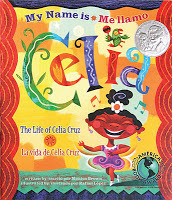
4. Are you connected to sharing bookjoy through Día?
MB: I am connected and committed to sharing bookjoy through Día! I'm not sure that folks who haven't been to a Día celebration can fully understand the joy and delight on the faces of children. There are worlds between the pages of books, and when I'm reading and working and playing with children at a Día event, I am bringing them on an adventure to these new worlds.
5. Did you always want to be a writer?
MB: I always wanted to express myself creatively, and that took different forms. Theater was probably my first venue of creative expression, and then books and writing. Believe it or not, being an English major seemed a lot more "practical" than being an actor or director! For this reason, I enjoy the performative aspects of working with children and Día and during presentations, I involve children in the music and dance of my books. I joke that my presentations are up and out of the rocking chair.
6. Have you always thought of yourself as creative? How do you nurture your creative life?
MB: My mother was an amazing artist and she nurtured me and inspired me. I also grew up in a home surrounded by incredible art, which I feel helped me think visually and helped me to better write for artists. The picture book is the meeting place of text and art, after all. My mother also instilled confidence in me, something that any writer needs, because no matter how good you are, rejection becomes a regular presence for writers. But in the present, the way I nurture my own creativity by be open to the magic and sometimes craziness of each and every day. Laughter is a big part of that, and also searching out new experiences. I often find inspiration and renewal in the works of my fellow artists—in writing, film, theater and music.
7. Are you working on other writing projects?
MB: I am working on several projects—in my mind at least. Part of the work will have to wait until I go on sabbatical next year. The hardest part about being an academic as well as a children's author is simply my lack of time. I want to write, but during the semester, my students need to come first, not to mention my daughters, my family, and my community! With so much negativity going on in my state around issues of immigration there are some things that are politically pressing. Luckily, when I do have the time to write, I can be very focused. My most immediate plans are to finish a middle grade novel based on the character in my new picture book, Marisol McDonald Doesn't Match .

8. What is a favorite time of your day?
MB: I like different times of day for different reasons. Afternoon naps are delicious, but so is sharing a cup of coffee with my husband in in our backyard underneath the ponderosa pines. When my daughters were little, there was no greater joy than Saturday and Sunday mornings when they tumbled into bed with us. Now that I have a teen and a tween, I look forward to picking them up from school and hearing about their days—they usually both talk at once in a jumble. As for writing, it really only ever is the mornings for me, when my energy is up and things are at their most hopeful.
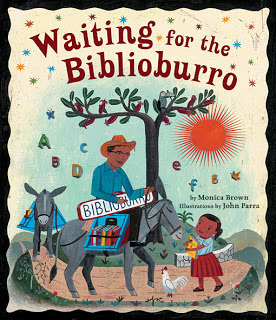 View book trailers.
View book trailers.
See teacher resources for Monica's books on her website.
Read a downloadable bio and brochure.
 1. You are an author, presenter, professor, friend and inspiration to many, and a family member. Wow! Do you enjoy your academic life?
1. You are an author, presenter, professor, friend and inspiration to many, and a family member. Wow! Do you enjoy your academic life?
MB: I do enjoy being a professor—for the decade before I started writing children's books I had the pleasure of teaching and writing about the most amazing Latino/a literary works and introducing college students to new worlds of literature. I think the best preparation for writing is reading, so I had the best training of all. First, teaching, researching, and talking about Latino/a literature and then I began creating Latino/a literature for children, inspired by the birth of my two daughters, Isabella and Juliana. I wanted them to know who Gabriela Mistral was, who Celia Cruz was.
2. Is there a connection between that life and your work as an author for children? Has being a writer changed your teaching?
MB: The two are intimately connected, in mostly positive ways. For example, when I was researching my book on Gabriel Garcia Marquez, I decided to develop a new class—a comparative literature of the Americas. I taught a senior seminar that compared magical realist texts by U.S. Latino/a authors such as Luis Urrea's The Hummingbird's Daughter, Ana Castillo's So Far from God, and Marie Arana's Cellophane to South American novels such as Isabel Allende's House of Spirits and Gabriel Garcia Marquez's seminal One Hundred Years of Solitude, a book that changed the direction of my life. I first read One Hundred Years of Solitude when I was a senior in high school and it captured me as no other, perhaps before or since. This teaching and writing led me to the publication of my very own magic realist text for children, Chavela and the Magic Bubble .

 3. Tell us briefly about your publishing journey and your newest books
.MB: My publishing journey is long in that it started, I think, long before I published my first children's book, and even before I published my first scholarly book. My mind, even as a child, was never quiet, for better or for worse. In some ways I had a fairy tale journey into children's books because the first manuscript I ever wrote, on Gabriela Mistral, secured a publisher and the first book I ever published,
My Name is Celia: The Life of Celia Cruz/Me Llamo Celia: La Vida de Celia Cruz
(and the second I wrote), was honored with awards. But I like to say that I spend years honing my craft—first as new graduate working as a journalist in Guadalajara in 1991, and then through my scholarly writing in graduate school and beyond. I was very lucky to meet my agent, Stefanie Von Borstel and her partner, Lilly Ghahremani, who were two amazing women of color just founding Full Circle Literary. So in addition to having a supportive husband and family, I had an amazing Latina agent who had my back and shared my vision.
3. Tell us briefly about your publishing journey and your newest books
.MB: My publishing journey is long in that it started, I think, long before I published my first children's book, and even before I published my first scholarly book. My mind, even as a child, was never quiet, for better or for worse. In some ways I had a fairy tale journey into children's books because the first manuscript I ever wrote, on Gabriela Mistral, secured a publisher and the first book I ever published,
My Name is Celia: The Life of Celia Cruz/Me Llamo Celia: La Vida de Celia Cruz
(and the second I wrote), was honored with awards. But I like to say that I spend years honing my craft—first as new graduate working as a journalist in Guadalajara in 1991, and then through my scholarly writing in graduate school and beyond. I was very lucky to meet my agent, Stefanie Von Borstel and her partner, Lilly Ghahremani, who were two amazing women of color just founding Full Circle Literary. So in addition to having a supportive husband and family, I had an amazing Latina agent who had my back and shared my vision.

4. Are you connected to sharing bookjoy through Día?
MB: I am connected and committed to sharing bookjoy through Día! I'm not sure that folks who haven't been to a Día celebration can fully understand the joy and delight on the faces of children. There are worlds between the pages of books, and when I'm reading and working and playing with children at a Día event, I am bringing them on an adventure to these new worlds.
5. Did you always want to be a writer?
MB: I always wanted to express myself creatively, and that took different forms. Theater was probably my first venue of creative expression, and then books and writing. Believe it or not, being an English major seemed a lot more "practical" than being an actor or director! For this reason, I enjoy the performative aspects of working with children and Día and during presentations, I involve children in the music and dance of my books. I joke that my presentations are up and out of the rocking chair.
6. Have you always thought of yourself as creative? How do you nurture your creative life?
MB: My mother was an amazing artist and she nurtured me and inspired me. I also grew up in a home surrounded by incredible art, which I feel helped me think visually and helped me to better write for artists. The picture book is the meeting place of text and art, after all. My mother also instilled confidence in me, something that any writer needs, because no matter how good you are, rejection becomes a regular presence for writers. But in the present, the way I nurture my own creativity by be open to the magic and sometimes craziness of each and every day. Laughter is a big part of that, and also searching out new experiences. I often find inspiration and renewal in the works of my fellow artists—in writing, film, theater and music.
7. Are you working on other writing projects?
MB: I am working on several projects—in my mind at least. Part of the work will have to wait until I go on sabbatical next year. The hardest part about being an academic as well as a children's author is simply my lack of time. I want to write, but during the semester, my students need to come first, not to mention my daughters, my family, and my community! With so much negativity going on in my state around issues of immigration there are some things that are politically pressing. Luckily, when I do have the time to write, I can be very focused. My most immediate plans are to finish a middle grade novel based on the character in my new picture book, Marisol McDonald Doesn't Match .

8. What is a favorite time of your day?
MB: I like different times of day for different reasons. Afternoon naps are delicious, but so is sharing a cup of coffee with my husband in in our backyard underneath the ponderosa pines. When my daughters were little, there was no greater joy than Saturday and Sunday mornings when they tumbled into bed with us. Now that I have a teen and a tween, I look forward to picking them up from school and hearing about their days—they usually both talk at once in a jumble. As for writing, it really only ever is the mornings for me, when my energy is up and things are at their most hopeful.
 View book trailers.
View book trailers. See teacher resources for Monica's books on her website.
Read a downloadable bio and brochure.
Published on November 14, 2011 05:28
ALSC's New Dia Website
Great news! Today the Association of Library Service to Children (ALSC) launches it's new Día website. Congratulations! In addition to information and resources you can view a short welcome video from Pat on the new site.
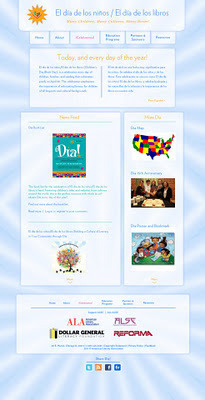


Published on November 14, 2011 05:21
November 7, 2011
Meet the 2011 Mora Award Winners
I'm so pleased that the contact personnel at the two 2011 Mora Award winning libraries agreed to a blog interview. First we'll hear from Sylvia Cisneros, Senior Librarian, Youth Services at the Santa Ana Public Library (CA.)
1. How did you first become interested in Día and how long ago was that?
SC: I had the privilege to live in Mexico for eleven years, between the ages of one and twelve. During that time, I learned and lived everything about the Mexican community like never imagined. Día de los Niños has been one of the most important celebrations within my family and the Mexican community. Schools, businesses and large organizations close every year on this day to dedicate it to the children in Mexico. This was not an exemption in our small town, called El Granjenal in the state of Michoacan. This celebration stayed with me all my life, and therefore, when I started conducting Spanish storytime in 2002, I always had the desire to incorporate Día as part of my themes. It wasn't until 2007 that I decided to celebrate, and without knowing that Día already existed within libraries, I created my own program. It was a simple program, with games, stories, and cupcakes for the kids.
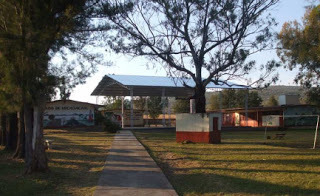 Sylvia's school
2. When did you begin to plan your 2011 celebration? Did you work with a team and who created the team?
Sylvia's school
2. When did you begin to plan your 2011 celebration? Did you work with a team and who created the team?
SC: Our planning for our 2011 celebration began in November of 2010. This was going to be our 3rd year celebration and we knew we wanted to have a greater celebration than what we had in our previous years, therefore Lupita Vega (Youth Services Principal Librarian) and I, decided that we were going to have all the youth services staff involved in the project.
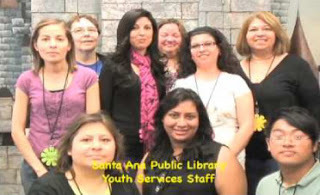 Sylvia and her team
Sylvia and her team
Top row, L to R: Michelle Loera, Linda Hanks, Lupita Vega, Olga Gallardo, Rose Navarro
Bottom row, L to R: Elvia Hernandez, Sylvia Cisneros, Kevin Le
3. What do you think made your 2011 celebration special?
SC: The enthusiasm from our team members and the community was great, and this made the entire planning process and the event itself to come out as expected. The invited authors, book sale, and special performances made this celebration especial!
4. How do you and your library feel about winning the Mora Award?
SC: Día has become our most attended event in our library and therefore the most important. Winning the Mora Award is very satisfying; it brings us joy! Most important it lets us know in that we are doing a wonderful job promoting literacy, cultures and celebrating children all at the same time.
5. What did you learn from your celebration this year?
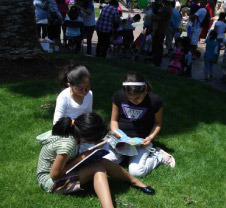 SC: I have learned that Día can really bring families together and that it can be an event that not only promotes the importance of reading but that it informs our community on different services that they probably are not aware of and from which they can benefit from.
SC: I have learned that Día can really bring families together and that it can be an event that not only promotes the importance of reading but that it informs our community on different services that they probably are not aware of and from which they can benefit from.
6. What three key pieces of advice would you give to those ready to plan their first Día celebration in spring 2012? Advice to those who have celebrated before?
SC: For those libraries that will be planning their first Día, my advice would be:
1) Start planning and promoting early 2) Always work with a team 3) Don't be afraid to go big and ask organizations for help.
For those who have celebrated before, my advice is to continue with the celebration, and to find ways of making their event larger and better each year.
7. Do you think of yourself as creative?
SC: I believe everyone is creative. As we start imagining, ideas come out. When I plan any events, I think of originality, and look for alternatives and possibilities, but I always think about the audience we will be serving in the program. I focus on the words FUN and EDUCATIONAL and proceed from there.
8. Why are Día and sharing bookjoy important to you?
SC: Día is very important for me and the staff here at Santa Ana because we are not only celebrating with the community an event that they respect and believe in but because we incorporate and make it stronger by promoting the joy of books. We try to promote the pleasure of reading, the outcomes of a good reader, and the importance of sharing books as a family.

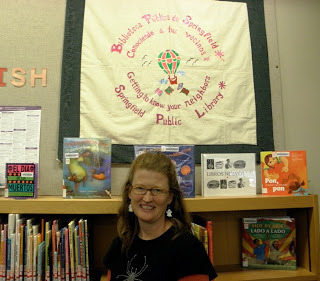 My name is Emily Ziglinski and I am the Latino Liaison for the Springfield Public Library (OR.) I have been working in libraries for about 8 years and with the Latino community for over 20. Being a librarian is the best job in the world. I am soooo lucky to do what I do.
My name is Emily Ziglinski and I am the Latino Liaison for the Springfield Public Library (OR.) I have been working in libraries for about 8 years and with the Latino community for over 20. Being a librarian is the best job in the world. I am soooo lucky to do what I do.
1. How did you first become interested in Día and how long ago was that?
EZ: My first library job was with Multnomah Public Library in Portland, Oregon. I was hired as a bilingual clerk and worked at the St Johns branch. I started working for MCL in 2003, the year after they had won the Mora Award. We had a wonderful bilingual Library Assistant who was in charge of organizing our Día event. I learned a lot from her in how she involved our community and really made it a neighborhood celebration. My contribution to the event was helping with the table activities, which were literacy based. My experience helping with and observing the Día events at MCL during my three years working there, definitely helped me be prepared for organizing the event here at Springfield Public Library.
2. When did you begin to plan your 2011 celebration? Did you work with a team and who created the team?
EZ: I had a small, but dedicated team for our Día event; our wonderful library volunteer, Faviola Arceo Garcia and the Latino Liaison for the Girl Scouts in our area, Martha Morales, and myself. We started working on ideas in January. I have already had community members and organizations asking to be involved for Día 2012!
3. What do you think made your 2011 celebration special? EZ: Community involvement
4. How do you and your library feel about winning the Mora Award?
EZ: We are ecstatic! We are pleased as a smaller library to be recognized for our work reflecting and embracing our entire community. The monetary award also triples our program budget for Día, for this we are VERY thankful.
5. What did you learn from your celebration this year?
EZ: I need to schedule more people to help with clean-up! This is true, but seriously, I think that the thing I learned most from Día this year is that once you have your base program plan in place, it is easy for the event to generate excitement and grow on its own. This was my second year planning Día for SPL and so I had a general idea of what the day would look like. I could then concentrate my energy on bringing more people to the table. With each person that gets involved more energy and ideas are generated. It becomes organic – growing and blooming with only a little care. It is fun to watch and to be a part of.
6. What three key pieces of advice would you give to those ready to plan their first Día celebration in spring 2012? Advice to those who have celebrated before?
EZ: First Día – 1) Know your community: who will come, who can help, what languages and cultures do you need to consider when planning, etc. 2) Give away books in the different languages of your community if you can. We did not have enough for every child, but we had a raffle. Kids were so excited to have a new book. I think it also helps tie the whole day together – a fun day dedicated to BOOKJOY! 3) Take good notes to build on your base for the future.
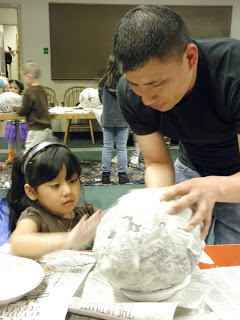 To those who have celebrated before: One of the goals of Día is promoting literacy, be open minded about what can be considered a literacy-based activity. Some parents have a low literacy level, so including crafts & activities that they can participate in with their children is important. For example we had a piñata making workshop as part of our celebration. Parents and children talked about designs and parents shared stories with their children. These narratives are a part of literacy.
To those who have celebrated before: One of the goals of Día is promoting literacy, be open minded about what can be considered a literacy-based activity. Some parents have a low literacy level, so including crafts & activities that they can participate in with their children is important. For example we had a piñata making workshop as part of our celebration. Parents and children talked about designs and parents shared stories with their children. These narratives are a part of literacy.
7. Do you think of yourself as creative? EZ: Yes, but not when talking about myself. (smile)
8. Why are Día and sharing bookjoy important to you?
EZ: I believe in the power of knowledge and the power of community, I guess that is why I became a public librarian. Día and bookjoy are really about embracing these two concepts. Plus, Día is about celebrating children, and programming for children is one aspect I love about my job.
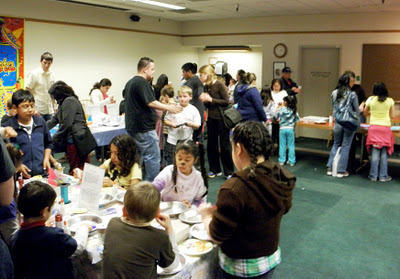

1. How did you first become interested in Día and how long ago was that?
SC: I had the privilege to live in Mexico for eleven years, between the ages of one and twelve. During that time, I learned and lived everything about the Mexican community like never imagined. Día de los Niños has been one of the most important celebrations within my family and the Mexican community. Schools, businesses and large organizations close every year on this day to dedicate it to the children in Mexico. This was not an exemption in our small town, called El Granjenal in the state of Michoacan. This celebration stayed with me all my life, and therefore, when I started conducting Spanish storytime in 2002, I always had the desire to incorporate Día as part of my themes. It wasn't until 2007 that I decided to celebrate, and without knowing that Día already existed within libraries, I created my own program. It was a simple program, with games, stories, and cupcakes for the kids.
 Sylvia's school
2. When did you begin to plan your 2011 celebration? Did you work with a team and who created the team?
Sylvia's school
2. When did you begin to plan your 2011 celebration? Did you work with a team and who created the team?
SC: Our planning for our 2011 celebration began in November of 2010. This was going to be our 3rd year celebration and we knew we wanted to have a greater celebration than what we had in our previous years, therefore Lupita Vega (Youth Services Principal Librarian) and I, decided that we were going to have all the youth services staff involved in the project.
 Sylvia and her team
Sylvia and her teamTop row, L to R: Michelle Loera, Linda Hanks, Lupita Vega, Olga Gallardo, Rose Navarro
Bottom row, L to R: Elvia Hernandez, Sylvia Cisneros, Kevin Le
3. What do you think made your 2011 celebration special?
SC: The enthusiasm from our team members and the community was great, and this made the entire planning process and the event itself to come out as expected. The invited authors, book sale, and special performances made this celebration especial!
4. How do you and your library feel about winning the Mora Award?
SC: Día has become our most attended event in our library and therefore the most important. Winning the Mora Award is very satisfying; it brings us joy! Most important it lets us know in that we are doing a wonderful job promoting literacy, cultures and celebrating children all at the same time.
5. What did you learn from your celebration this year?
 SC: I have learned that Día can really bring families together and that it can be an event that not only promotes the importance of reading but that it informs our community on different services that they probably are not aware of and from which they can benefit from.
SC: I have learned that Día can really bring families together and that it can be an event that not only promotes the importance of reading but that it informs our community on different services that they probably are not aware of and from which they can benefit from. 6. What three key pieces of advice would you give to those ready to plan their first Día celebration in spring 2012? Advice to those who have celebrated before?
SC: For those libraries that will be planning their first Día, my advice would be:
1) Start planning and promoting early 2) Always work with a team 3) Don't be afraid to go big and ask organizations for help.
For those who have celebrated before, my advice is to continue with the celebration, and to find ways of making their event larger and better each year.
7. Do you think of yourself as creative?
SC: I believe everyone is creative. As we start imagining, ideas come out. When I plan any events, I think of originality, and look for alternatives and possibilities, but I always think about the audience we will be serving in the program. I focus on the words FUN and EDUCATIONAL and proceed from there.
8. Why are Día and sharing bookjoy important to you?
SC: Día is very important for me and the staff here at Santa Ana because we are not only celebrating with the community an event that they respect and believe in but because we incorporate and make it stronger by promoting the joy of books. We try to promote the pleasure of reading, the outcomes of a good reader, and the importance of sharing books as a family.

 My name is Emily Ziglinski and I am the Latino Liaison for the Springfield Public Library (OR.) I have been working in libraries for about 8 years and with the Latino community for over 20. Being a librarian is the best job in the world. I am soooo lucky to do what I do.
My name is Emily Ziglinski and I am the Latino Liaison for the Springfield Public Library (OR.) I have been working in libraries for about 8 years and with the Latino community for over 20. Being a librarian is the best job in the world. I am soooo lucky to do what I do.1. How did you first become interested in Día and how long ago was that?
EZ: My first library job was with Multnomah Public Library in Portland, Oregon. I was hired as a bilingual clerk and worked at the St Johns branch. I started working for MCL in 2003, the year after they had won the Mora Award. We had a wonderful bilingual Library Assistant who was in charge of organizing our Día event. I learned a lot from her in how she involved our community and really made it a neighborhood celebration. My contribution to the event was helping with the table activities, which were literacy based. My experience helping with and observing the Día events at MCL during my three years working there, definitely helped me be prepared for organizing the event here at Springfield Public Library.
2. When did you begin to plan your 2011 celebration? Did you work with a team and who created the team?
EZ: I had a small, but dedicated team for our Día event; our wonderful library volunteer, Faviola Arceo Garcia and the Latino Liaison for the Girl Scouts in our area, Martha Morales, and myself. We started working on ideas in January. I have already had community members and organizations asking to be involved for Día 2012!
3. What do you think made your 2011 celebration special? EZ: Community involvement
4. How do you and your library feel about winning the Mora Award?
EZ: We are ecstatic! We are pleased as a smaller library to be recognized for our work reflecting and embracing our entire community. The monetary award also triples our program budget for Día, for this we are VERY thankful.
5. What did you learn from your celebration this year?
EZ: I need to schedule more people to help with clean-up! This is true, but seriously, I think that the thing I learned most from Día this year is that once you have your base program plan in place, it is easy for the event to generate excitement and grow on its own. This was my second year planning Día for SPL and so I had a general idea of what the day would look like. I could then concentrate my energy on bringing more people to the table. With each person that gets involved more energy and ideas are generated. It becomes organic – growing and blooming with only a little care. It is fun to watch and to be a part of.
6. What three key pieces of advice would you give to those ready to plan their first Día celebration in spring 2012? Advice to those who have celebrated before?
EZ: First Día – 1) Know your community: who will come, who can help, what languages and cultures do you need to consider when planning, etc. 2) Give away books in the different languages of your community if you can. We did not have enough for every child, but we had a raffle. Kids were so excited to have a new book. I think it also helps tie the whole day together – a fun day dedicated to BOOKJOY! 3) Take good notes to build on your base for the future.
 To those who have celebrated before: One of the goals of Día is promoting literacy, be open minded about what can be considered a literacy-based activity. Some parents have a low literacy level, so including crafts & activities that they can participate in with their children is important. For example we had a piñata making workshop as part of our celebration. Parents and children talked about designs and parents shared stories with their children. These narratives are a part of literacy.
To those who have celebrated before: One of the goals of Día is promoting literacy, be open minded about what can be considered a literacy-based activity. Some parents have a low literacy level, so including crafts & activities that they can participate in with their children is important. For example we had a piñata making workshop as part of our celebration. Parents and children talked about designs and parents shared stories with their children. These narratives are a part of literacy. 7. Do you think of yourself as creative? EZ: Yes, but not when talking about myself. (smile)
8. Why are Día and sharing bookjoy important to you?
EZ: I believe in the power of knowledge and the power of community, I guess that is why I became a public librarian. Día and bookjoy are really about embracing these two concepts. Plus, Día is about celebrating children, and programming for children is one aspect I love about my job.

Published on November 07, 2011 04:23
October 31, 2011
Wonderful AASL in MN
[image error]
I was so excited flying to Minneapolis last week to speak at the American Association of School Librarians (AASL), a group I'd not met before. Talk about committed literacy professionals! The librarians at all levels—elementary, middle and high schools, as well as university faculty members—all expressed how much they enjoyed their work and the excitement of their students.
As always, I learned so much from my conversations with these professionals, one of the joys of being a presenter. Not enough of the school librarians were familiar with Día , but many are eager to plan their first culminating Día celebrations for this coming April. I hope that they, and all of you who may be planning your April book fiestas, are finding helpful information on the Día section of my site and on the various links on the site. I welcome your suggestions and ideas.
AASL members ready to promote the Día family literacy concept to their schools and districts, brainstormed about how to increase Día's impact within their organization and in the national literacy community. Ideas included presentations/sessions about planning Día events at district, state, regional and national meetings.
Join us in linking all children to books, languages, and cultures. Be part of establishing the national tradition of celebrating El día de los niños/El día de los libros, Children's Day/Book Day just as we annually celebrate Mother's Day and Father's Day. Share bookjoy!
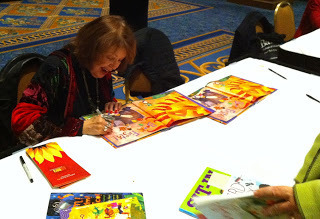 Pat signing books following the Author Banquet
Pat signing books following the Author Banquet
As always, I learned so much from my conversations with these professionals, one of the joys of being a presenter. Not enough of the school librarians were familiar with Día , but many are eager to plan their first culminating Día celebrations for this coming April. I hope that they, and all of you who may be planning your April book fiestas, are finding helpful information on the Día section of my site and on the various links on the site. I welcome your suggestions and ideas.
AASL members ready to promote the Día family literacy concept to their schools and districts, brainstormed about how to increase Día's impact within their organization and in the national literacy community. Ideas included presentations/sessions about planning Día events at district, state, regional and national meetings.
Join us in linking all children to books, languages, and cultures. Be part of establishing the national tradition of celebrating El día de los niños/El día de los libros, Children's Day/Book Day just as we annually celebrate Mother's Day and Father's Day. Share bookjoy!
 Pat signing books following the Author Banquet
Pat signing books following the Author Banquet
Published on October 31, 2011 11:31
October 20, 2011
Winners of the 2011 Mora Award Announced!
[image error]
Congratulations to the Santa Ana Public Library (CA) and the Springfield Public Library (OR) winners of the 2011 Estela and Raúl Mora Award!
The award was established in 2000 by author Pat Mora and her family to honor their parents and to motivate libraries to celebrate "Día," El día de los niños/El día de los libros, Children's Day/Book Day on April 30th.
Read the full press release in English and in Spanish.
The award was established in 2000 by author Pat Mora and her family to honor their parents and to motivate libraries to celebrate "Día," El día de los niños/El día de los libros, Children's Day/Book Day on April 30th.
Read the full press release in English and in Spanish.
Published on October 20, 2011 10:45
October 13, 2011
Who won the 2011 Estela and Raúl Mora Award?
 Twelve wonderful applicants. REFORMA will announce the two winners next week. My congratulations and thanks to all who applied and my thanks to the REFORMA Mora Award Committee, especially the chair Beatriz Pascual Wallace.
Twelve wonderful applicants. REFORMA will announce the two winners next week. My congratulations and thanks to all who applied and my thanks to the REFORMA Mora Award Committee, especially the chair Beatriz Pascual Wallace.http://www.patmora.com/dia/mora_award.htm

Published on October 13, 2011 04:00
October 5, 2011
Opportunity Nation
I've joined Opportunity Nation, a campaign to help put promoting opportunity, social mobility and access to the American Dream back on the national, state and local community agendas.The Opportunity Nation campaign officially kicks off at a national summit on Nov 4. Click here to sign up to watch a livestream of the event. You can also participate on the web on Nov 4 to lend your voice to the discussion.
Published on October 05, 2011 12:24
September 29, 2011
REFORMA in Denver
I felt so fortunate attending REFORMA's fourth national conference, also its 40th Anniversary, two weeks ago. REFORMA was founded by Dr. Arnulfo D. Trejo in 1971. An ALA affiliate, REFORMA is the National Association to Promote Library and Information Services to Latinos and the Spanish-Speaking. As I said in my luncheon presentation, many groups talk about diversity, but REFORMA lives that commitment so though the focus is "Elevating Services to Latinos," the members are, like our country, of varying ethnicities.
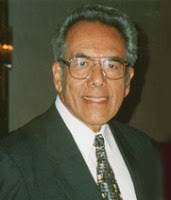 Dr. Arnulfo D. TrejoOn a personal note, it was so exciting for me to have my wonderful son-in-law, Dr. Roger Martinez, a historian, and my co-author, my older daughter Libby, at the lunch. The librarians were quick to take her photo which made me smile.
Dr. Arnulfo D. TrejoOn a personal note, it was so exciting for me to have my wonderful son-in-law, Dr. Roger Martinez, a historian, and my co-author, my older daughter Libby, at the lunch. The librarians were quick to take her photo which made me smile.
How energized I was by library students and experienced librarians so excited about Día. Dr. Jamie Naidoo, a professor at the University of Alabama, organized a Día Showcase and provided a helpful PowerPoint. He and I read Book Fiesta! , I spoke about Día's history, Linda Mays, from ALSC shared information about the upcoming Día web site, and Beatriz Pascual, chair of the Mora Award, spoke about the award process. Energetic Jamie had organized a poster session and various Día librarians brought posters and information about their events. So inspiring!
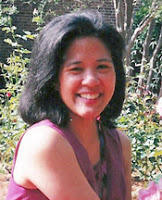 Beatriz Pascual
Beatriz Pascual
 Dr. Jamie Naidoo
Dr. Jamie Naidoo
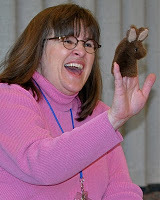 Kathleen Barrett DusenberyIn my remarks, I said that some people immediately "get Día." They understand that linking all children to books, languages and culture is actually patriotic work since literacy is essential for a true democracy. So many committed librarians bring so much creativity and energy to their Día work. I smiled when one such librarian, Kathleen Barrett Dusenbery from Longmont Public Library in CO, later e-mailed and said , "I do get Día!"
Kathleen Barrett DusenberyIn my remarks, I said that some people immediately "get Día." They understand that linking all children to books, languages and culture is actually patriotic work since literacy is essential for a true democracy. So many committed librarians bring so much creativity and energy to their Día work. I smiled when one such librarian, Kathleen Barrett Dusenbery from Longmont Public Library in CO, later e-mailed and said , "I do get Día!"
I hope you "get Día" too. Culminating celebrations of the day-by-day commitment to link children and books will be celebrated next April, Día's Sweet Sixteenth Anniversary. Be part of extending the Mother's Day/Father's Day tradition to Children. Join us in sharing bookjoy and annually celebrating Children's Day/Book Day, El día de los niños/El día de los libros in many languages. We want Día celebrated in homes, libraries, schools, colleges/universities, museums, community centers, etc. For more information about Día including a planning booklet for your Día year, visit http://www.patmora.com/dia/diaplanning.htm.
 Dr. Arnulfo D. TrejoOn a personal note, it was so exciting for me to have my wonderful son-in-law, Dr. Roger Martinez, a historian, and my co-author, my older daughter Libby, at the lunch. The librarians were quick to take her photo which made me smile.
Dr. Arnulfo D. TrejoOn a personal note, it was so exciting for me to have my wonderful son-in-law, Dr. Roger Martinez, a historian, and my co-author, my older daughter Libby, at the lunch. The librarians were quick to take her photo which made me smile.How energized I was by library students and experienced librarians so excited about Día. Dr. Jamie Naidoo, a professor at the University of Alabama, organized a Día Showcase and provided a helpful PowerPoint. He and I read Book Fiesta! , I spoke about Día's history, Linda Mays, from ALSC shared information about the upcoming Día web site, and Beatriz Pascual, chair of the Mora Award, spoke about the award process. Energetic Jamie had organized a poster session and various Día librarians brought posters and information about their events. So inspiring!
 Beatriz Pascual
Beatriz Pascual
 Dr. Jamie Naidoo
Dr. Jamie Naidoo  Kathleen Barrett DusenberyIn my remarks, I said that some people immediately "get Día." They understand that linking all children to books, languages and culture is actually patriotic work since literacy is essential for a true democracy. So many committed librarians bring so much creativity and energy to their Día work. I smiled when one such librarian, Kathleen Barrett Dusenbery from Longmont Public Library in CO, later e-mailed and said , "I do get Día!"
Kathleen Barrett DusenberyIn my remarks, I said that some people immediately "get Día." They understand that linking all children to books, languages and culture is actually patriotic work since literacy is essential for a true democracy. So many committed librarians bring so much creativity and energy to their Día work. I smiled when one such librarian, Kathleen Barrett Dusenbery from Longmont Public Library in CO, later e-mailed and said , "I do get Día!" I hope you "get Día" too. Culminating celebrations of the day-by-day commitment to link children and books will be celebrated next April, Día's Sweet Sixteenth Anniversary. Be part of extending the Mother's Day/Father's Day tradition to Children. Join us in sharing bookjoy and annually celebrating Children's Day/Book Day, El día de los niños/El día de los libros in many languages. We want Día celebrated in homes, libraries, schools, colleges/universities, museums, community centers, etc. For more information about Día including a planning booklet for your Día year, visit http://www.patmora.com/dia/diaplanning.htm.
Published on September 29, 2011 05:00
September 8, 2011
Inspiring Sweden
As I mentioned in my September newsletter, last month I spent a week in the beautiful and proudly bilingual country of Sweden. Travel usually includes surprises, and this trip to Stockholm and Uppsala was no exception. At the Stockholm airport, I was pleasantly surprised by photographs of famous Swedish authors—including the children's book author Astrid Lindgren. The time in Stockholm included a visit to Skansen, an open air museum and zoo. There, in the drizzle, I encountered the geese below as my husband Vern and I visited traditional homes and gardens and chatted with employees dressed in period costumes. Our hosts at each location cheerfully answered questions in Swedish or English giving us a sense of the families that had once lived in the wooden homes with sod roofs.
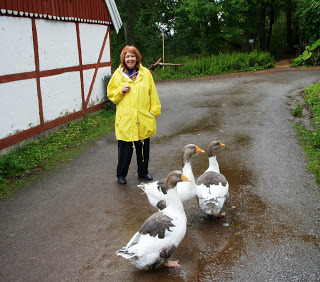
On the following day, we went back to the island of Djurgarden to visit Junibacken, a fairy tale house that honors the much-loved Astrid Lindgren, author of the Pippi Longstocking books. My youngest is a red-head, so years ago, I gave her some Pippi books. The building was full of children and parents enjoying rooms from Lindgren's books. Lots of chaos! When Vern and I boarded the "story train," considered the highlight of a visit, we were asked in what language we would like to hear the audio. No, the sets weren't slick as U.S. theme parks can be, but I loved the way an entire building was dedicated to connecting children with books through fun, one of our Día goals.
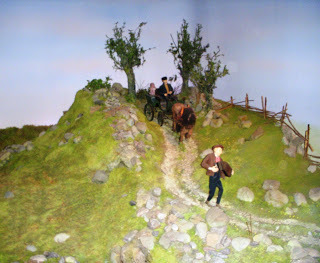
Luckily for me, my husband's conference hotel in Uppsala was right by Carl Linnaeus' garden. Remember Linnaeus, the father of taxonomy? I vaguely remembered him, and since I love gardens, I became excited about a visit. What a day I had visiting the museum in what was once his home and wandering the garden rows reading the Latin names he had assigned and that I've been learning such as helianthus anus for the annual sunflower variety. What odd comfort to see the familiar Latin names used by gardeners and botanists all over the world. I bought books about Linnaeus whose life and journey now fascinate me. Bookjoy: through print being connected with those in the past whose passions affect our world.
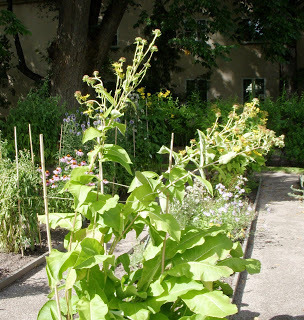


On the following day, we went back to the island of Djurgarden to visit Junibacken, a fairy tale house that honors the much-loved Astrid Lindgren, author of the Pippi Longstocking books. My youngest is a red-head, so years ago, I gave her some Pippi books. The building was full of children and parents enjoying rooms from Lindgren's books. Lots of chaos! When Vern and I boarded the "story train," considered the highlight of a visit, we were asked in what language we would like to hear the audio. No, the sets weren't slick as U.S. theme parks can be, but I loved the way an entire building was dedicated to connecting children with books through fun, one of our Día goals.

Luckily for me, my husband's conference hotel in Uppsala was right by Carl Linnaeus' garden. Remember Linnaeus, the father of taxonomy? I vaguely remembered him, and since I love gardens, I became excited about a visit. What a day I had visiting the museum in what was once his home and wandering the garden rows reading the Latin names he had assigned and that I've been learning such as helianthus anus for the annual sunflower variety. What odd comfort to see the familiar Latin names used by gardeners and botanists all over the world. I bought books about Linnaeus whose life and journey now fascinate me. Bookjoy: through print being connected with those in the past whose passions affect our world.

Published on September 08, 2011 04:00
September 1, 2011
Early Literacy Project
Sandra Lamm, Early Childhood Coordinator with the Library Department in Fort Worth, Texas, shared a project created by a family at one of the city's Early Childhod Resource Centers. Sandra wrote "Erica Rodrigues said that
Let's Eat! ¡A Comer!
is the favorite book of her daughters, Julianna and Brianna, ages 2 and 3. Mrs. Rodrigues said they read the book over and over, and she said, 'What I like about this book is that to be happy you only need simple things.'
So for their project they covered a piece of Styrofoam with construction paper to make a table, and then replicated the food that the family shared in the book with items they found around the house. We took a couple of pictures – So creative!"
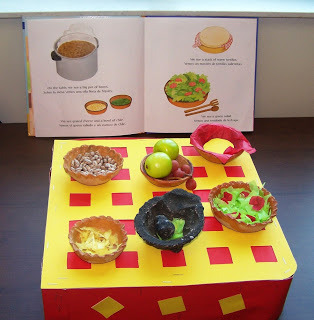
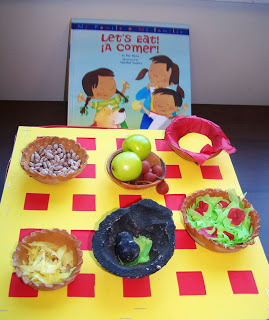
Sandra also wrote a description of her library's program. "Early Childhood Matters (EMC) is a program of the Fort Worth Library, launched in 2006 in response to the number of children entering kindergarten without the skills they needed to be successful in school. ECM is a neighborhood-based free program that helps parents and other caregivers of children from birth to age five learn how to prepare their children for kindergarten and beyond. Parenting sessions, resource materials, and high quality children's books are offered in English and Spanish in six high-need neighborhoods in Fort Worth. The program is supported by the City of Fort Worth, a grant through the US Department of Health and Human Services, and collaboration with many community partners.
ECM focuses on early literacy and pre-reading skills. Pat Mora's beautiful bi-lingual books capture the interest of adults and children alike, support early language and pre-reading development, and reflect family and cultural values. Our participants are delighted with them."
So for their project they covered a piece of Styrofoam with construction paper to make a table, and then replicated the food that the family shared in the book with items they found around the house. We took a couple of pictures – So creative!"


Sandra also wrote a description of her library's program. "Early Childhood Matters (EMC) is a program of the Fort Worth Library, launched in 2006 in response to the number of children entering kindergarten without the skills they needed to be successful in school. ECM is a neighborhood-based free program that helps parents and other caregivers of children from birth to age five learn how to prepare their children for kindergarten and beyond. Parenting sessions, resource materials, and high quality children's books are offered in English and Spanish in six high-need neighborhoods in Fort Worth. The program is supported by the City of Fort Worth, a grant through the US Department of Health and Human Services, and collaboration with many community partners.
ECM focuses on early literacy and pre-reading skills. Pat Mora's beautiful bi-lingual books capture the interest of adults and children alike, support early language and pre-reading development, and reflect family and cultural values. Our participants are delighted with them."
Published on September 01, 2011 08:09
Pat Mora's Blog
- Pat Mora's profile
- 96 followers
Pat Mora isn't a Goodreads Author
(yet),
but they
do have a blog,
so here are some recent posts imported from
their feed.



